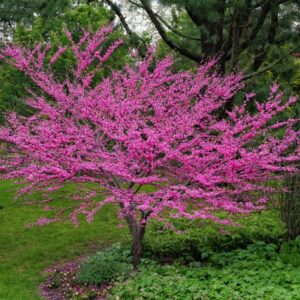Description
Sweet Birch Tree (Betula lenta) – 1-Year-Old Seedling
Overview
The Sweet Birch (Betula lenta) is a medium-sized deciduous tree prized for its fragrant bark and foliage. This fast-growing species is commonly found in woodlands and is known for its aromatic properties, which are utilized in making birch beer and birch syrup. Its smooth, silvery-gray bark and bright green leaves turn a beautiful yellow in the fall, adding aesthetic value to any landscape. Ideal for areas with well-drained, moist soil, the Sweet Birch is perfect for gardens, parks, and natural wooded areas.
Sweet Birch Native Range
Native to eastern North America, Sweet Birch is commonly found in the Appalachian regions and other parts of the northeastern U.S., thriving in moist, well-drained soils.
Growth and Form
- Height: Grows 18–24 inches per year, reaching 40–50 feet at maturity.
- Spread: Has a canopy spread of 20–30 feet at maturity.
- Growth Rate: Moderate to fast-growing.
- Foliage: Glossy, dark green leaves turn brilliant yellow in the fall.
- Bark: Smooth, silvery-gray bark that becomes more distinctly aromatic with age.
Ecological Benefits
- Wildlife Habitat: Provides food and shelter for various species, especially birds and small mammals.
- Shade: The Sweet Birch’s large canopy provides excellent shade for parks, yards, and urban areas.
- Soil Health: The fallen leaves decompose into rich organic matter that improves soil quality.
Sweet Birch Hardiness and Climate Tolerance
- Hardiness Zones: 3–7, suitable for a wide range of climates.
- Cold Tolerance: Cold-hardy, withstanding temperatures down to -30°F (-34°C).
- Drought Tolerance: Prefers regular moisture but can tolerate moderate drought once established.
- Soil Preferences: Thrives in moist, well-drained soils, but can adapt to a variety of soil types.
Planting and Care
- Planting Location: Prefers full sun to partial shade, in areas with good air circulation and space for growth.
- Watering: Regular watering during dry periods is essential, especially in the early years.
- Fertilization: Apply a balanced, slow-release fertilizer in the spring to support healthy growth.
- Pruning: Minimal pruning is needed. Remove any dead or damaged branches in late winter or early spring.
Uses
- Birch Beer and Syrup: The bark and sap of the Sweet Birch are used to produce birch beer and birch syrup, prized for their unique flavors.
- Landscaping: Ideal for parks and gardens, offering shade and beautiful fall color.
- Timber: The wood of the Sweet Birch is hard and durable, often used in furniture making and cabinetry.
Potential Problems
- Pests and Diseases: Susceptible to aphids, leaf miners, and birch borer. Regular monitoring and care are recommended.
- Watering Needs: Needs consistent moisture, especially during dry spells when young







Reviews
There are no reviews yet.